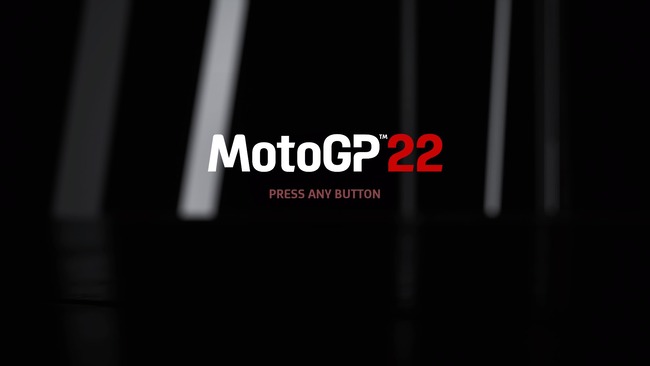It’s fair to say ALL of the MotoGP games are hard when you first play them, but MotoGP 22 is particularly brutal in terms of difficulty. It just has a very hard handling and braking model that means a lot of players might be able to set one clean lap, but being consistent for multiple laps in a row without crashing off the bike is very very difficult.
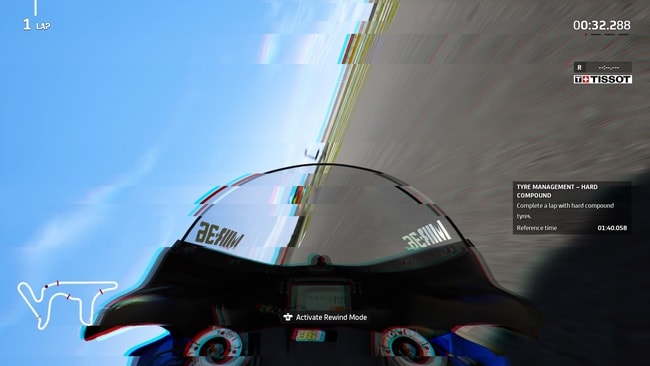
This will be a very common sight when you first play MotoGP 22
It has to be said that some players just got completely fed up with this game and turned it off well before the game’s life cycle ended. And I don’t entirely blame them as it’s a very frustrating game to play even if you put some serious hours of practice in. It can feel like even applying some clear principles to get better, the braking especially is inconsistent and the same inputs on the same corner produces different outcomes on different laps.
That said, I’m going to put together a guide with some key tips to try and make the game less difficult and at least playable long term, for people that really want to stick with it.
Let’s get started.
Get Your Braking Technique Right
This is the first thing that usually catches the newer players of MotoGP games out. The braking and cornering physics are totally different to other racing games. You need to begin braking and cornering much earlier than 4 wheel racing sims.
But even experienced MotoGP players are still finding the ’22 game very hard to get used to.
Here’s a very general outline for the correct braking/cornering technique:
- Only brake with the bike fully upright and in a straight line.
- Apply the front brake first for heavy stopping zones, optionally adding some rear brake if needed to add more stopping power.
- Once you’ve scrubbed off enough speed, release the front brake and lean into the corner (you need to start leaning much earlier than for 4 wheel racing sims).
- You can also sometimes dab the rear brake only when cornering to get the bike leaned into sharper corners more.
- Once you hit the apex, ease back on the accelerator and power out of the corner.
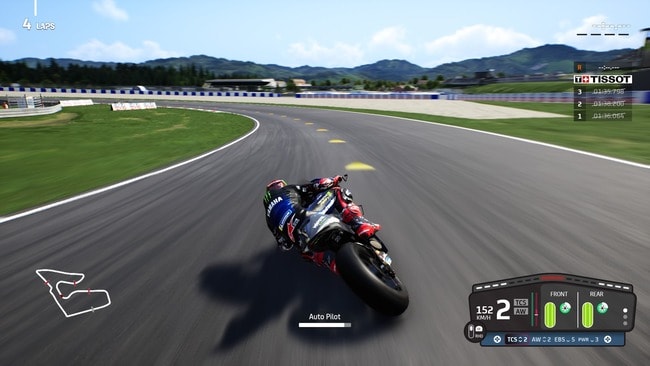
And then just as importantly, here’s things NOT to do when braking on MotoGP 22:
- Don’t ever apply the front brake when leaning heavily. You can sometimes get away with lightly applying the rear brake, but never the front brake while cornering.
- Don’t brake too late as even slightly over-doing it, you’re almost certain to run off the track on this game, which then leads to crashes. Always brake too early rather than too late for consistency.
If you do over-run a braking zone slightly, you can sometimes rescue it by frantically tapping (but not holding) repeatedly on the front and rear brake. But the braking physics are very unforgiving on MotoGP 22 and mistakes in braking are punished much more than other games, so it’s more about getting the braking zones memorised and always being cautious on braking to avoid over-shooting.
See my full guide on how to brake properly on MotoGP 22 for much more detailed tips on the correct braking technique for this game – what to do and what to avoid doing to be consistent.
Turn On Some Assists
Your next option if you’re finding this game too hard is turn some of the assist of Riding Aids on, or turn them up.
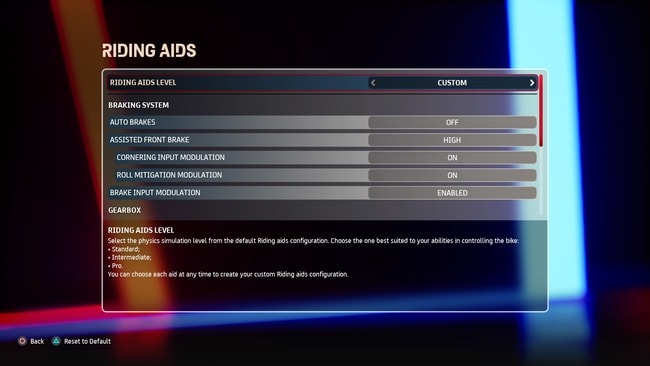
Your main assists to make the braking/cornering/traction easier are:
- Assisted Front Brake – High or Moderate
-
- Cornering Input Modulation – On or Moderate
- Roll Mitigation Modulation – On or Moderate
-
- Brake Input Modulation – Enabled
- Manual Start Management – On (harder – personal preference)
- Acceleration Input Modulation – Enabled
- Cornering Input Modulation (Steering) – Enabled
- Off Track Aid – On
Turning on or turning up all these settings make the handling more forgiving, although even with all these Riding Aids enabled, MotoGP 22 is still a hard game to be consistent on.
Another crucial assist is to set Bike Recovery to Disabled. This is a confusingly worded assist, but disabled is the easier option as it automatically re-spawns you back on the bike after crashes, so you lose less time. With it turned on, you have to run to and retrieve a crashed bike yourself, which costs you more time.
There is also an Auto Brakes option that literally handles all the braking for you, so you can just focus on the cornering and track layouts. This is good to turn on if you’re totally new to this game and just want to learn the handling physics, but sooner or later it’s best to disable this and customise the assists below it as per the above suggestions.
See my full guide on recommended Riding Aids to enable for players starting out on MotoGP 22, to to make the game less difficult.
Adopt a Restrained & Cautious Mindset
When you break it down, it’s usually over-applying the throttle for too long and not braking early enough that causes crashes on all these games, and especially on MotoGP 22.
And when you go one step back from this, I would argue it’s because a lot of sim racers and carrying with them the mindset they used for other racing games of being aggressive and late on the braking trying to go as deep as possible into corners to find extra lap time.
But this doesn’t really work on the MotoGP games, and especially the ’22 edition which has unforgiving braking physics. You need to really ditch this mindset from other games and also reverse it into a more cautious, patient and reserved mindset to be consistent on MotoGP 22.
Here’s some tips in this regard:
- ALWAYS err on the side of braking too early rather than too late on this game, especially for heavier braking zones after straights. For some corners, brake even before the racing line tells you to avoid over-running.
- Focus on rhythm and consistency and following the Ideal Trajectory (racing line) rather than “pushing” too much to find extra lap time like you would on other racing games. Pushing is often what causes you to over-shoot corners and/or crash.
- Mentally map circuits into “blocks” or sections – where can you really open up on the throttle (usually only 1 or 2 long straights max), and where do you need to forget that and just rely on short dabs, bursts and squirts on the throttle? Once the full throttle stuff is out the way each lap, change your mindset to caution/restraint, and just dab/coast your way round the twisty sections until you reach the long straight(s) again.
- Get rid of any muscle memory and mindset you may have from 4 wheel racing games (especially F1 games) of pushing aggressively to “find” extra lap time. Instead, almost adopt a less is more mindset with MotoGP bikes, where being restrained and cautious is actually what delivers the lap time and consistency.
As impossible as it may seem when you first play the game, it is possible to get good on MotoGP 22. See the video below for an example of someone playing MotoGP 22 and in many ways even finding it too easy.
Example Of Smoothness and Consistency On MotoGP 22
Notice how smooth and consistent he is on his inputs, not really looking like he’s pushing, but still setting good lap times and being very consistent, hardly ever falling off.
That’s what you need to aim for to get good on MotoGP 22, though in fairness it’s clear that the guy in this video as been playing these games for years and so has a head-start on someone starting new. But his kind of approach is what you need to mimic as much as possible.
Change Some Bike Setup Parameters
There are also some setup changes you can make for MotoGP bikes in particular that can deliver stronger braking power from the brakes and engine, to prevent over-running corners so much.
Here’s the main settings to tweak:
- Use a larger front brake disc
- Increase the Slipper Clutch value
- Increase the Engine braking value on your ECU dash.
Let’s explain each one a bit more:
Front brake disc – The 355 mm disc is the thickest one and delivers the strongest stopping power. But it can also make the braking more difficult to control. Use this one if you can control the braking and want to stop over-running corners so much. If you keep crashing under braking, the 340 mm High Mass disc delivers a bit less stopping power but makes the braking a bit easier.
Slipper Clutch – A setting contained within the Gear Ratio settings within the bike setup. Increasing this value to 7 deliver stronger engine braking, which can also help prevent over-shooting of corners.
Engine braking – A setting on your ECU dashboard. Increase to 4 or 5 to give the maximum braking force from the engine which can again reduce the over-running of corners that’s so common on this game.
Switch to Moto2 or Moto3 Bikes Instead
One factor that makes the handling of MotoGP bikes in particular difficult is the speed at which everything moves. The GP bikes have insane power delivery and acceleration which leaves very little margin for error and makes controlling them very difficult.
One way around this is to switch to the slower Moto2 and Moto3 bikes instead, with Moto2 being my own preferred class. These have slower acceleration and in general, everything is moving slower and gives you more time to react and correct mistakes.
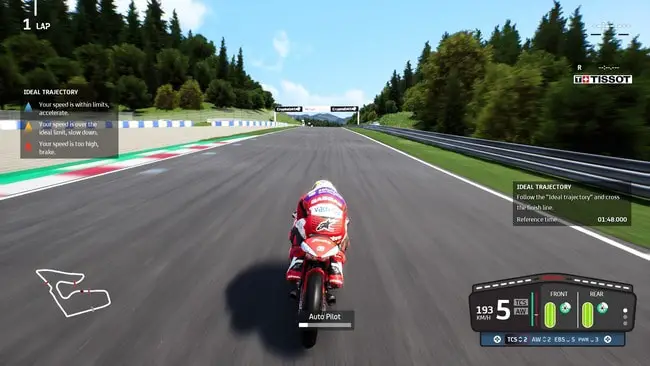
Because of the lower power delivery, these bikes also don’t “push on” or run wide in corners so much, so it’s easier to “catch” small mistakes and get back on the racing line if you overshoot slightly.
Therefore, it’s advised to start your practice and career modes on these lower category bikes to begin with for an easier leaning curve. The Tutorials game mode progresses you up through the classes so you can see the handling difference clearly.
Reduce The AI Difficulty Level
Another option if you’re struggling with consistency and still falling off the bike a lot is to reduce the AI level to at least stay competitive and catch up to the pack after crashes.
It’s not fun continually crashing, falling to the back of the pack and finishing races 30+ seconds behind the next bike because you can’t make up the time you lost. Therefore any AI level you use needs to take into account how many times you’re falling off in races on average, and not just the pure outright lap times of the AI.
Here’s a rough guide on the AI level to use depending on how difficult you’re finding the game:
Still struggling and constantly falling off – If you’re still crashing every few corners, there’s probably no AI level that will work. You can try something really low like 20%, but you’re likely better of practicing on Time Trial and applying some of the other principles laid out in this guide.
Beginner level – Where you’re starting to slowly get used to the game but still crashing quite a lot, using 30-40% might work as the pace is slow and allows you to catch the pack if you make a mistake.
Getting better – If you’ve put some serious hours in and are starting to get better, but still falling off once or twice per race, then 50-60% might work, as you can recover at this level as well. If you’ve got used to the game and set even a halfway decent lap though, you’ll smoke the AI on this level.
Pretty consistent – If you’ve really put some time into this game and are still using assists but are pretty solid and consistent, 70% is a good level and what I settled on after putting some time in.
Fast and consistent – Anything above 70% is reserved for fast and consistent players who rarely or never fall off.
See my full guide on finding a suitable AI level for MotoGP 22, for more on this.
Switch To MotoGP 23
This is kind of a strange tip, but MotoGP 23 is generally regarded to be a much easier game in terms of the general handling. I’d certainly agree with this based on my own experience playing both games in recent months. I much prefer MotoGP 23 and wouldn’t go back to playing ’22.
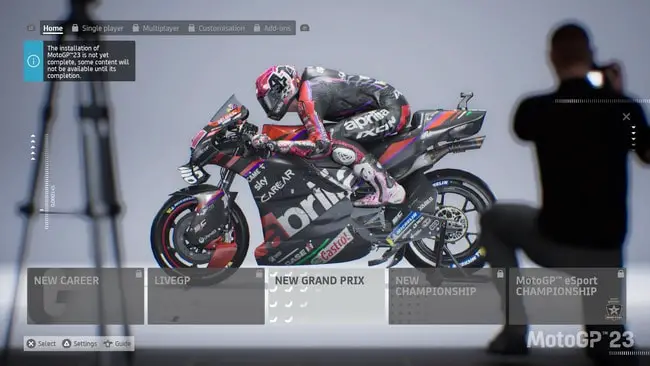
MotoGP 23 just has much more friendly braking physics in general compared to MotoGP 22. It’s far easier to make corners without over-running them, and it’s easier to get into a rhythm lapping most of the easier circuits especially without falling off so much.
Don’t get me wrong, MotoGP 23 has it’s own unique challenges with the handling. For example the front brake physics are more sensitive and you can crash more easily if you apply the front brake while leaning or into downhill corners. The handling also feels more sluggish and “bogged down” compared to ’22 when you first play it (but I personally got used to this quite quickly).
But overall, I would argue it’s much easier to get into MotoGP 23 than it’s predecessor, and more easily get to the point where you can lap somewhat more consistently and enjoy the racing more.
Therefore, if the difficulty of MotoGP 22 is frustrating you too much and you’re not improving despite putting in loads of practice, consider switching to the ’23 edition instead.
See my full guide comparing the handling/physics/difficulty of MotoGP 23 vs ’22, for more in depth analysis of this.
